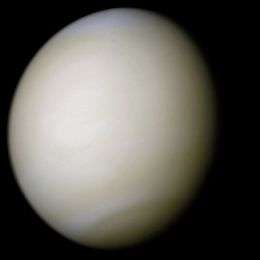List of extraterrestrial dune fields
This is a list of dune fields not on Earth which have been given official names by the International Astronomical Union. Dune fields are named according to the IAU's rules of planetary nomenclature. The relevant descriptor term is undae. As of now, the only two solar system bodies, besides Earth, with named dune fields are Venus and Mars. Dune fields have been discovered on Saturn's moon Titan.[1]
Venus
There are three officially named dune fields on Venus. They are named after desert goddesses, as per the IAU's rules. They are listed below.
- Al-Uzza Undae 67.7N, 90.5E - named after Uzza, an Arabian desert goddess
- Menat Undae 24.8S, 339.4E
- Ningal Undae 9.0N, 60.7E - named after Ningal, the wife of the Sumerian desert god Sin
Mars

There are five officially named dune fields on Mars, which are named after nearby classical albedo features in accordance with the IAU's rules. All five of them lie between 75°N to 85°N, between Planum Boreum and Vastitas Borealis. These dune fields span over 200 degrees of longitude. They are listed below.
- Abalos Undae[2]
- Aspledon Undae
- Hyperboreae Undae
- Namib Undae (unofficial)
- Olympia Undae
- Siton Undae
In addition, as part of the Mars Exploration Rover mission, a small dune field unofficially named El Dorado on the south side of Husband Hill in Gusev crater was investigated by the Spirit rover from sols 706 to 710.[3] Analysis of El Dorado showed that it consists of black wind-blown sand which is "well-sorted, well-rounded and olivine rich.[4]

(Curiosity rover; 17 December 2015).
Titan
References
A large portion of this article was sourced from the Gazetteer of Planetary Nomenclature, the official IAU database of planetary names.
- ↑ "Titan's Seas Are Sand". Retrieved 21 November 2006.
- ↑ "USGS Gazeteer of Planetary Nomenclature: Abalos Undae". Retrieved 8 August 2007.
- ↑ "Mars Exploration Rovers Update: Spirit Descends Husband Hill as Opportunity Works at a Standstill on Olympia". Retrieved 21 November 2006.
- ↑ "Recent results from the Spirit rover at Gusev crater" (PDF). Retrieved 21 November 2006.
- 1 2 3 Arnold, K.; J. Radebaugh; C. J. Savage; E.P. Turtle; R.D. Lorenz; E.R. Stofan; A. Le-Gall & the Cassini Radar Team. "Areas of Sand Seas on Titan from Cassini Radar and ISS: Fensal and Aztlan" (PDF). 42nd Lunar and Planetary Science Conference, March 7–11, 2011 at The Woodlands, Texas. LPI Contribution No. 1608. Lunar and Planetary Institute. p. 2804.
- 1 2 Le Gall, A.; M.A. Janssen; L.C. Wye; J. Radebaugh; R.D. Lorenz & the Cassini Radar Team (September 2010). "Regional variations among Titan's dunes: Belet versus Fensal dune fields" (PDF). European Planetary Science Congress 2010 Abstracts. 5: 247.
